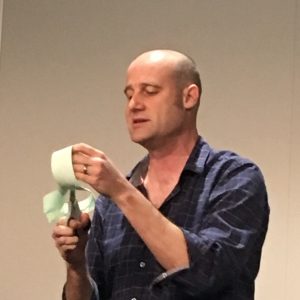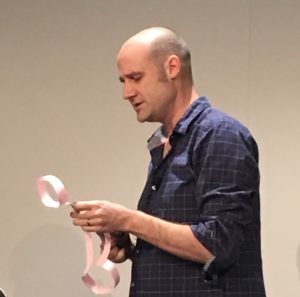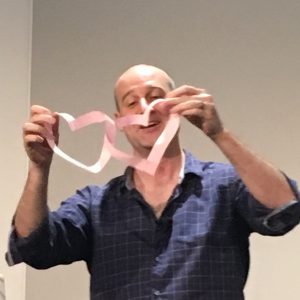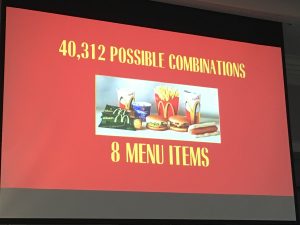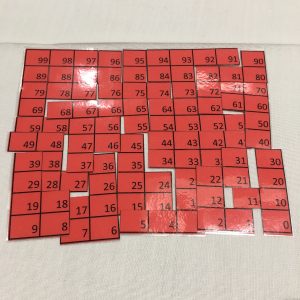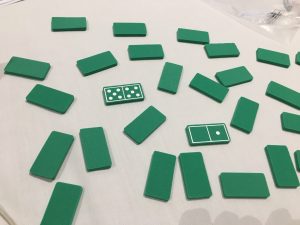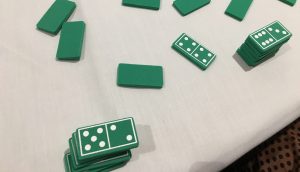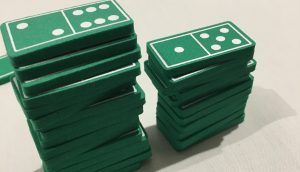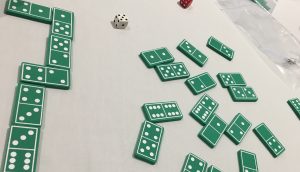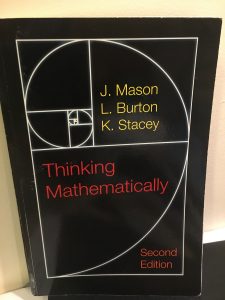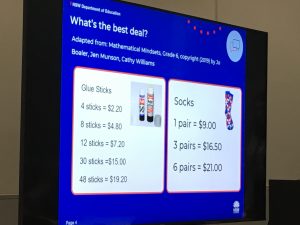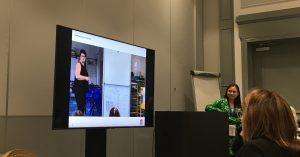This blog is the first of two reflections on the annual MANSW (Mathematical Association of NSW) conference. This year’s theme was “Mathematics: The Greatest Show” and it didn’t disappoint! What an amazing conference, ever year it gets bigger and better and the calibre of presentations and keynotes was out of this world! (I should save this phrase for next year’s conference actually as the theme will be A Maths Odyssey: Space … and geometry!)
Let the show begin!
Matt Parker aka @standupmaths was the opening keynote. His presentation wove together aspects of comedy, entertainment, and the sheer joy of mathematics. As a previous mathematics teacher, Matt has the power as a speaker to not only engage people as the audience of a show (and it was tremendously funny!) but also to engage people as learners (and it was extremely knowledge-building).
📝 Edutainment: can & should maths be entertaining? Some thoughts from @standupmaths (not shown here: the hilarious impracticality of McCombinations) #manswgreatestshow @MathsNSW pic.twitter.com/er93k1jyaZ
— Eddie Woo (@misterwootube) September 19, 2019
Matt enthralled the audience of some 600+ teachers with his ‘ooo’ and ‘ahhh’ causing Moebius loop tricks. Although as Matt highlighted himself, it’s the mathematics itself that is amazing, we just need to learn how to harness that in our classrooms for our students. I’m sure plenty of those teachers in the room would have tried out these ideas back in the classroom last week. If you are a NSW primary teacher and still have the CD ROM Teaching Space and Geometry, there are two lessons that link to Matt’s paper tricks – “Two Rings Puzzle” and “Moebius Strips”. The Moebius strip lesson poses questions such as: How many surfaces does the ring have? How many edges does the ring have? If the ring were cut along the middle, what would happen? What is your prediction and why? How do you think the Moebius strip was constructed? How could you check?
Why am I learning this? Why does it work?
In exploring different tasks with the Moebius loops Matt made the point of saying “Don’t tell this students this!” as he explained some of the ‘why it works’ parts of the task. This resonated with me, teaching isn’t about telling. Students need to feel the maths-burn and think hard. Thinking hard is part of learning mathematics. Matt also said that every mathematician thinks maths is hard. People who enjoy maths know it’s difficult, and enjoy this aspect of challenge. It’s hard work teaching your brain new thinking skills that lead to developing intuition.
“Humble Pie: A comedy of maths errors” is Matt’s new book about some of the funny, and often unfortunate, ways in which things have gone wrong because of basic mathematical errors. Matt shared a few of these stories during his keynote like the McDonald’s combination meals where they used factorial instead of combinations to work out the number of different meals it was possible to make. And the story about the plane that had to make an emergency landing due to an error (twice!) with kg vs pounds of fuel. I can’t do Matt’s story-telling ability justice so you’ll just have to buy the book!
Matt also shared some cool digital image investigations using spreadsheets (every mathematics teachers’ dream!). Information about this tasks and lesson plans to go with it can be found here on Matt’s website think-maths.co.uk He also has a couple of other websites mathsgear.co.uk and standupmaths.com You should also subscribe to his youtube collaboration Numberphile these videos are great for your own learning or to use as hooks during the launch of your mathematics lessons. Some of my favourites are the How to order 43 Chicken McNuggets, The scientific way to cut a cake, Calculating Pi with real pies and 43,252,003,274,489,856,000 Rubik’s Cube Combinations. I also attended Matt’s paper folding workshop – I’ll share my reflections on that workshop in part 2 of this blog.
Building Number Sense in Early Primary, Doug Clarke
Doug’s sessions are always great (Doug Clarke is a regular presenter both at the annual MANSW conference and at the K-8 PAM conference – keep an eye on the MANSW conference page for upcoming conferences). Doug provided some great new ways to utilise the hundreds chart jigsaw idea. Asking students as they are putting the chart back together: What number goes there? How do you know? There’s a piece missing, draw me a picture of what it looks like. If I know the numbers 21 and 43 are on the same piece, what might that piece look like?
Domino games were also part of Doug’s workshop, I really like the foam dominoes Dough uses, the numbers are really clear and they don’t make any noise. We played roll two dice, then find the matching domino to the dice. Player with the most dots (not dominoes) at the end wins. This opens up a lovely investigation around how the students count the dots. Doug coined a nice phrase to use with the students “How can I used clever counting?” to get the students communicating about their ways of counting the dots. You could also pose questions like: What strategies did you use? What strategy is efficient? Why? You could also adapt to the player with most dominoes at the end wins (highest stack).
Other domino games included Highest sum, turn over one domino each at the same time, add your domino dots, highest total keeps their domino for that round, continue play. At the end, the same scoring can be used as above, most dots wins. Lowest difference was another game, same as above, turn over one domino each at the same time, lowest difference between the two lots of dots on your own domino wins and keeps their domino for that round. This one was really interesting as students soon realise there are dominoes you want to get and ones that you don’t – I’ll let you work that out for yourselves! Crack the code was a good game to engage all students working collaboratively across groups. In this game, each pair of students work together to arrange their set of dominoes into two piles – all face up. They need to use a rule (that they keep secret) to organise the dominoes into the two piles. One member of each pair then visits other pairs to try to guess or predict the rule that group is using to separate their dominoes. A great discussion starter, the teacher could take photos of a group’s piles, put it up on the interactive whiteboard for a whole class discussion.
Think it … Say it, Ayesha Ali Khan
Ayesha Ali Khan (follow @missalikhan and @DoE_Mathematics) is currently the Primary Mathematics Advisor at the Department of Education and presented a workshop focusing on classroom conversations centred on mathematical concepts. She was accompanied by her colleagues Linda De Marcellis @linda_demar and Cathy Vogt @cathyvogt6. Ayesha’s session was really informative and referenced all the go-to researchers who currently are exploring the importance of talk in the mathematics classroom. One of the strategies Ayesha mentioned was the ‘convince yourself, convince a friend, convince a skeptic‘ that’s referenced by both Jo Boaler on youcubed and also by Robert Kaplinsky. It’s a way of exploring argumentation that I was first introduced to by Peter Gould, it originally comes from Mason, Burton and Stacey’s book “Thinking Mathematically” – a must read, and one that still holds true for the classroom some 30+ years after its first publication.
This cycle—convince yourself, convince a friend, convince a skeptic —can be used in different ways. One technique is first to encourage students to understand the problem well enough that they believe they have come up with a correct solution. Next they produce a justification that could be convincing to someone else in the class. The final level is a justification that is complete enough to be convincing to someone who found a different solution or might disagree with the solution provided. With this cycle, students construct arguments that grow in sophistication.
The Cycle of Challenge, excerpt from Back-pocket Strategies for argumentation, Graham & Lesseig
In Ayesha’s session we also explored how to talk, to support students’ learning of mathematics, using the Talk Move strategies. I’ve discussed the benefits of talk moves in other blogs you can read such as; 6 practices that should be in your mathematical repertoire and valuing student voice in mathematics. The Department have created some video vignettes that showcase talk moves being used in classroom settings, these will be available soon – I hope! Contact Ayesha for more details. Ayesha also mentioned Mike Askew’s work around private (pair chats) and public (whole class) conversations and also Kazemi and Hintz‘s strategies such as compare and connect and why, let’s justify from their book Intentional Talk – another must-read.
Well that was the end of day one! I’ll continue reflecting on day 2 of the conference in my next blog. If you are keen to find out what other conference-goers enjoyed about the conference you can check out the Twitter feed #manswgreatestshow
References
Graham, M., & Lesseig, K. (2018). Back-Pocket Strategies for Argumentation. Mathematics Teacher, 112(3), 172-178.
Mason, J, Burton, L, & Stacey, K. (1982). Thinking Mathematically. London: Addison-Wesley. National Council of Teachers of Mathematics (NCTM).
